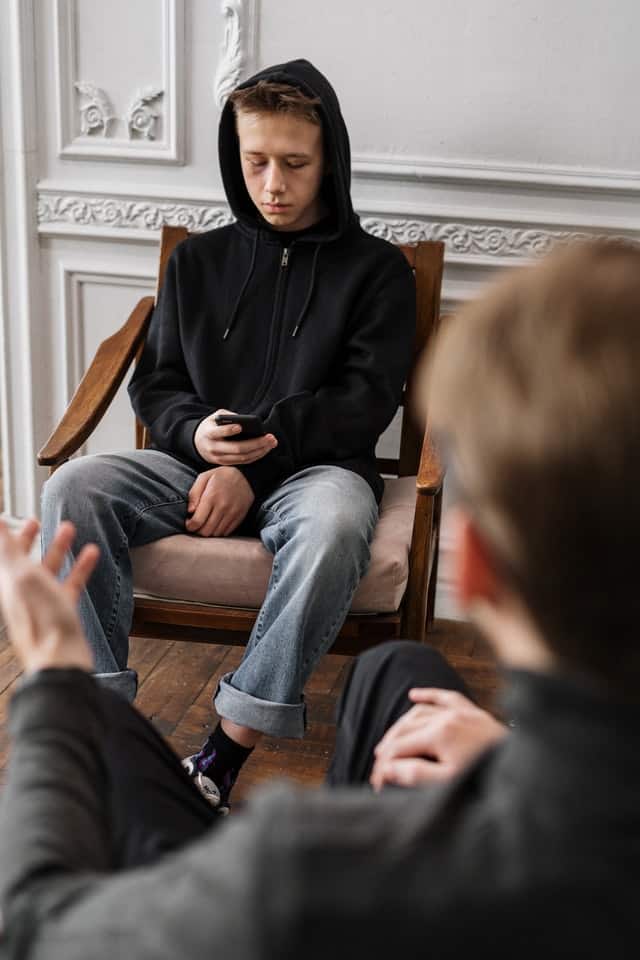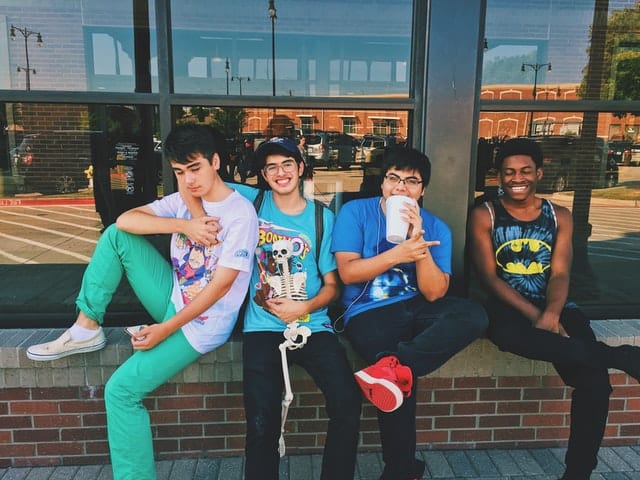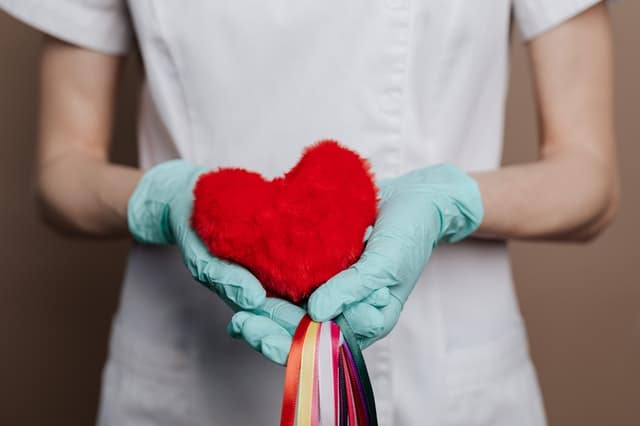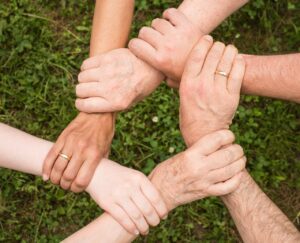“Everything has been figured out, except how to live.” – Jean-Paul Sartre, French philosopher
When a child comes into the world, sadly, he or she doesn’t come with a bright yellow “Children From 0-18 Years For Dummies” book, an authoritative how-to guide on how to care for and nurture your newborn baby until they’re old enough to go off to college or university, and finally, that day arrives when you get to kick them out of your house. With love and best wishes, of course. Children of any age bring high points that make everything so worthwhile – wondrous moments when, just for a little while, you think you’ve cracked it and found the heavenly secret to life. High points like the first time they walk, stumble and walk some more across your living room carpet, and then totter lovingly into your arms. Or their first words… “Momma” or “Daddy.” Simply beautiful. Undoubtedly, there are those other times too. All eventually forgiven, of course. Screaming and hollering for candy on what it appears to be (surprisingly) the busiest day of the year down at the local supermarket. On a Tuesday? In April? Who’d have thought it? Or the first time they unexpectedly use the f-word. In a house full of guests. Including Grandma and Grandpa. And the local preacher. Bless their little cotton socks. And then there’s that time that every parent knows is coming one day, and waits for – the first day you see them drunk. Or worse (perhaps), the first time you see them wasted… Your little one – now all grown up. So what happens next? Your reaction happens… “I thought I had taught them better than this.” “Why is my daughter doing this?” “How could my child betray me?” “I thought I could trust my son.” “Why didn’t I see the signs?” “What do I do now?” “Seriously, what do I do now?” Or do you say something else? Do you ground them? Ban their friends from coming over? Take away their phones? Cut their internet connection? Send them to their room without any dinner?… Or do you do something else, after first taking a very deep, parental breath? You aren’t alone. In fact, your child is among a significant number of U.S. students that are using or abusing substances. According to DoSomething.org, a 5 million-strong online organization of teenagers and young people (who source their information directly from the U.S. Department of Health & Human Services):
- 60% of high school seniors don’t see regular marijuana use as harmful; however, THC (the active ingredient in the drug that can cause addiction) is nearly 5 times stronger than it was just 20 years ago
- The U.S. represents only 5% of the world’s population and around 75% of prescription drugs taken, and 60% of teenagers who abuse prescription drugs get them free from friends and relatives
- By the 8th grade, 28% of youngsters have consumed alcohol, 15% have smoked cigarettes, and 16.5% have used marijuana
Your teen, like so many of their peers, is engaging in experimentation, and, in some cases, the abuse of drugs and alcohol . Teenage drug abuse is no joke, and even though the reasons are more complicated than just “teenagers being teenagers” or “social pressure,” it’s important to understand the actual “Why?” of teen drug use.

The Substances Most Commonly Used By Teenagers
For teenagers, the most popular substances used haven’t changed much for the past 5 decades. Alcohol, marijuana, and tobacco consistently rank among the top substances of abuse among youth. But other perils have become popular in recent years, such as how these products are marketed – not including nicotine, of course). The packaging and advertisements for alcoholic energy drinks, electronic cigarettes, and synthetic marijuana are designed to appeal specifically to teens. The abuse of medications such as cough syrups, anti-anxiety drugs, ADHD medications, and prescription pain relievers is less common, but, nonetheless, the side effects can be life-threatening. Fortunately, less than 1% of teens use heroin, crystal meth, or cocaine regularly:
| Type of drug | Prevalence |
| Alcohol | 33% |
| Marijuana | 23% |
| Electronic vaporizers | 13% |
| Cigarettes | 11% |
| Prescription stimulants | 3% |
| Prescription painkillers | 2% |
| Anti-anxiety drugs | 2% |
| LSD | 1% |
| Cocaine | 1% |
| Ecstasy | 1% |
| Inhalants | 1% |
Source: 2016 Monitoring the Future Survey The percentage of high school seniors who tried cigarettes has declined each year since 1998, and it reached an all-time low in 2016. Electronic vaporizers also declined in popularity between 2015 and 2016, the only two years that teens were asked about their use of the products.
Is Underage Drinking a Problem in Washington State?
Here in Washington state, and mirrored across every other state in the U.S., a new generation of potential alcoholics are becoming grown adults. The problem of children and young adults (those under the age of 21) cost the state of Washington $1.4 billion in 2007, according to the CDC, and included resulting medical care, and revenue from work loss. The 2016 Healthy Youth Survey taken by 6th, 8th, 10th, and 12th graders in Washington state produced worrying results:
- Most WA state students reported drinking 1-2 days during the month (with 12th graders reporting an exceedingly high rate of 32%)
- Among those students who drink, the majority use hard liquor, increasing their risk of alcohol poisoning
- Nearly 20% of 10th graders and 17% of 12th graders reported traveling in a car with a driver who had recently consumed alcohol
- Around 9% of 12th graders admitted to driving after using alcohol
Why You Need to Protect & Secure the Family Medicine Cabinet
Many adults save medications from a doctor’s prescription, so they can save money if they need them again. Parents may have been prescribed anti-anxiety drugs to treat sleep problems or to relieve anxious feelings, or they may have prescription painkillers left over from a surgery. It may seem to make sense to give them to your children if they get injured or feel anxiety before a big event, but that can be incredibly risky. Adult dosages are obviously different from teenage dosages, and simply cutting a pill in half doesn’t ensure you are giving your children a safe amount. Exposing them to prescription drugs without a doctor’s prescription also teaches them that it’s OK to get hold of them on their own, by simply taking them out of the family medicine cabinet without your knowledge. Important: Always seek medical advice before allowing your child to take a prescription medication, and always make sure to dispose of unused medications once they’re no longer needed.

Understanding Why Teenagers Experiment with Drugs & Alcohol
Suddenly, your adolescent child just isn’t acting like themselves: his or her grades are dropping, maybe they are more irritable than before, even disrespectful and defiant. He or she seems to be looking more tired or red-eyed, and spending more time with other teenagers you don’t know well. Acting on your gut instinct, you investigate their bedroom. You find an empty bottle of beer and marijuana paraphernalia… Before you do anything, it’s a good idea to understand exactly why teenagers use drugs and alcohol. Here are a few common reasons:
- Primarily, they’re just trying to fit in with peers. Peer pressure is a real factor in young adolescent life, and a definite motivator for teen drug abuse.
- If your teenager has a mental health issue, such as depression or anxiety, you should know that substance use coupled with such conditions share clear risk factors. According to the National Institute on Drug Abuse, “overlapping genetic vulnerabilities,” “overlapping environmental triggers,” and “involvement of similar brain regions” are just some reasons that teen substance abuse and mental health issues are often diagnosed together. Teenagers can be using substances to self-medicate their undiagnosed mental health condition.
- It is an experiment that has gone out of control. Or a way to self-medicate. Maybe they tried it once and somehow drug or alcohol use got out of control. Some users who do drugs for this reason still need intervention, and they may be more open to getting help.
- Teenagers also often think it’s quite normal to use drugs. There’s a lot of misinformation or just a lack of information about the dangers of drug use out there, and especially online. With marijuana laws opening up in more U.S. states, many teenagers are becoming convinced that it is a safe drug to use.
- Simply put, they are bored. A bored teen is a teen at a high risk of participating in illicit activities. Keeping your teen hanging out with the right people and in a variety of activities or an afterschool job can help keep them from becoming bored enough to participate in risky behaviors.
- Your teenager has developed an addiction. Your teen may be genetically predisposed to addiction, and therefore, it became more difficult for them to say “no” when they needed to. Now, they need help breaking their cycle of addiction.
Now that you are aware of the possible reasons that your teenager began and continues to use drugs or alcohol, it’s time to get your thoughts in order to prepare for discussing teenage substance use (and abuse) with them.
Get Educated: Learn About Teenage Substance Use
As kids get older, they often start to question the life lessons they hear from parents and teachers. They become more heavily influenced by the things they see on TV, the internet, and social media. Teens listen to what their peers say, and they pay attention to what celebrity role models do. As a result, they get mixed messages, and they have to determine which information to believe. Anti-drug messages such as “just say no” simply aren’t effective, as, sadly, they hear many more times that they’re ok. Teens need concrete reasons to avoid alcohol and other drugs, and they need facts and evidence. Parents definitely have to know what they’re talking about if they want their children to listen. So, let your education begin here…
What Effects Do Substances Have on Teenagers?
Most teens do not develop a substance use disorder after using drugs, but that doesn’t mean they aren’t vulnerable to a number of other risks. Additionally, as substances differ, so do their side effects. Here are the most common side effects associated with marijuana, alcohol, stimulants, opioids, and anti-anxiety medications:
Side effects of marijuana can include:
- Dizziness
- Increased heart rate
- Breathing problems
- Depression
- Anxiety
- Psychosis
Side effects of alcohol can include:
- High blood pressure
- Vision problems
- Weakened immune system
- Liver disease
- Sexual problems
- Alcohol poisoning
Side effects of stimulants, such as ADHD medications or cocaine, can include:
- Irritability
- Rapid heartbeat
- Drowsiness
- Paranoia
- Headaches
- Anxiety
Side effects of opioids, such as prescription painkillers or heroin, can include:
- Irregular breathing
- Dizziness
- Headaches
- Low blood pressure
- Seizure
- Overdose
Side effects of anti-anxiety drugs such as Xanax or Valium include:
- Confusion
- Fatigue
- Irritability
- Mood swings
- Insomnia
- Shaking
Addiction is the one risk that each drug has in common. Some drugs are more addictive than others, but with repeated use, teenagers can become addicted to any drug.
How Do Substances Affect the Growing Teenage Brain?
The developing teenage brain is naturally wired to be curious and seek new experiences. As it’s in this constant state of development, when substances, like drugs or alcohol, are introduced, the teenager’s brain will adapt to these addictive substances more quickly than an adult brain. Even though teenage brains are in this long period of growth and development, their brains will have a normal, working “reward system.” They feel pleasure and pain in ways similar to adults, but the vital decision-making areas of the brain are immature. Thus, teens are more likely to act on impulse or emotions, and certainly less likely to fully assess a possibly risky situation.
Dopamine & The Teenage Brain’s “Reward System”
The reward system works by releasing a small amount of a chemical called dopamine in the brain. Dopamine makes us feel happy. It’s naturally released to reward basic behaviors necessary to our survival, such as eating, exercising, or having sex. Other behaviors that teens find pleasurable, such as playing sports, listening to music or socializing, cause small dopamine releases. Drugs and alcohol affect the brain in a different way, by overloading the reward system with dopamine. The brain associates drug use with this positive reward, which causes teenagers to want to repeat the behavior. When teens use drugs regularly, the brain repeatedly adapts to the presence of the drugs and associates it with positive rewards. Some people are genetically more vulnerable to this adaptation than others, and they’re at an increased risk for developing an addiction. In those teens, the brain associates drug use with such positive rewards that the dopamine release caused by other activities no longer causes happiness. In simple terms, drug use becomes a top priority for the brain, and the parts of the brain in charge of self-control can no longer keep the reward system in check.
The “A & B” Process: How the Brain Adapts to Substance Use
One of the primary principles of brain function dictates exactly how, as a teenager becomes addicted to a particular substance, the effect of that substance significantly weakens, pushing the user or drinker to take larger quantities to get a similar effect. This is known as “tolerance.” However we try to affect the brain with foreign substances, the brain, in a direct and natural response, will adapt to counter this; this two-part action/reaction has been referred to as the “A & B” process. As Dr. Jusith Grisel, PhD describes in her book “Never Enough: The Neuroscience and Experience of Addiction,” there are 3 psychopharmacological rules that apply to substance use: “The very definition of an addictive drug is one that stimulates the mesolimbic pathway*, but there are three general axioms in psychopharmacology that also apply to all drugs:
- All drugs act by changing the rate of what is already going on.
- All drugs have side effects.
- The brain adapts to all drugs that affect it by counteracting the drug’s effects.”
* The “mesolimbic pathway” (also known as the “reward pathway”) is one of the major pathways the brain uses to deliver dopamine. The “A & B” Process applies predominantly to this third rule. More specifically, when a person uses a mind-altering substance, this is the “A” process, where the person experiences pleasure directly from the substance, whether it’s the sedation of alcohol or the kick of coke. In response to this, the “B” process follows, where the brain reacts by producing the exact opposite effect. This is the brain’s attempt to return itself to its normal state. As Grisel describes, it’s the reason why hangovers and coming down from a drug are usually unpleasant experiences. Because of the “B” process, and because our brains are exceptionally smart at returning ourselves to our normal state, a person will inevitably need more and more of the drug to feel the benefit of the “A” process. In other words, our brains are creating a tolerance to the substance. Not only that but when the brain recognizes the substance from its memory banks, the “B” process begins almost instantaneously. This is the very reason that alcoholics and drug addicts require their substance of choice to just feel normal. Quite simply, without it, they would only feel the effects of the negative “B” process.
Why Do Teenagers Engage in Risky Behavior Like Using Substances?
Teenagers will engage in risky behavior, like using substances, because of several factors. These include:
- Availability of drugs in the local neighborhood
- Prevalence of drug use among peers (other teenagers in their social group)
- Exposure to violence or trauma
- Parental alcohol or drug use
- Mental illness
- Poor impulse control
- Compulsive personality
One risk factor alone may not be enough to spur a teenager to drug use, but a combination of several factors increases the chances that a teen will try alcohol or other drugs. Protective factors, such as anti-drug messages in the community, extracurricular drug testing in school, and positive parental influence, can negate these risk factors to a limited extent. Teenagers use alcohol or other drugs for a number of reasons. They usually try addictive substances for the first time because of peer pressure or simply their own curiosity. The main reasons for teen drug use drugs include:
- To have fun
- To relax
- To feel good
- To forget about problems
- To relieve stress
- To look cool
- To fit in with friends
Teenagers who drink alcohol or use drugs have very few barriers to prevent them. In most cases, they aren’t afraid of getting caught, and they have little trouble finding substances of abuse.
Where Exactly Do Teenagers Find & Use These Substances?
It’s easy for teenagers to access alcohol and other drugs. They can buy drugs at school or buy alcohol, cigarettes or synthetic marijuana from gas stations with fake IDs. Drinking and drug use is very common at parties. If parents aren’t diligent, teens can steal prescription drugs from medicine cabinets, or even buy drugs on the internet and have them delivered in discreet packages. Even if you monitor who your child hangs out with, most teens know a “friend of a friend” who can access illicit drugs or get them alcohol. If they have a job, they may work with young adults who are willing to buy alcohol, tobacco products, or e-cigarettes for them. Teenagers are also exposed to alcohol and other drugs like never before, especially on social media. A 2012 study by the National Center on Addiction and Substance Abuse found that nearly half of teens surveyed said they’d seen teens drinking or using drugs on social media and that it seemed like those using them were having a good time. In fact, 75% of teens reported that seeing other teens drinking alcohol or smoking marijuana on social media sites encouraged other students to want to use them to have fun.
Drugs at School
Despite their best efforts, educators can’t control everything that students bring on and off school property. It isn’t just one or two bad apples selling drugs, though. You may be surprised at how prevalent drug trafficking is on school grounds. The National Center on Addiction and Substance Abuse study found:
- 44% of high schoolers know someone who sells drugs at school
- 52% said there was a place near school where students could drink or use drugs during the school day
- 36% said it was easy to use drugs or drink during school without getting caught
When students were asked exactly what drugs they could buy at school:
- 91% said marijuana
- 24% said prescription drugs
- 9% said cocaine
- 7% said ecstasy
The school day isn’t the only time students have access to addictive substances. Many parents seriously underestimate what happens when their children attend parties.
Parties
A 2006 survey by the National Center on Addiction and Substance Abuse found that a third of teens and nearly half of 17-year-olds have attended a house party chaperoned by parents where teens drank alcohol or used other drugs. Compared with teenagers who always attended parties with parents, teens who attended parties without parental supervision were:
- 15 times more likely to say illicit drugs were available
- 16 times more likely to say alcohol was available
- 29 times more likely to say marijuana were available
The difference between parental perceptions of parties and teenage reports of what was actually going on was dramatic:
- According to their parents:
-
- 80% of parents said neither alcohol nor marijuana was available at teen parties
- 98% of parents said they were present at teen parties at their homes
- 99% of parents said they wouldn’t serve alcohol at their teen’s party
- According to the teens:
-
- 50% of teens said they’d been to parties where alcohol or marijuana was available
- 33% of teens said parent supervision was rare or nonexistent at parties
- 28% of teens said they’d been to parties where both parents and alcohol were present
Numerous studies show that when parents allow their teenagers to drink a few sips of alcohol or allow them to drink at home, the children are far more likely to drink outside of the home.
How Does the Legalization of Marijuana Affect Teenagers?
Several states have legalized marijuana for medicinal and recreational purposes. However, research isn’t clear on how medicinal marijuana legalization affects teens. In Colorado and Washington, states that have legalized recreational marijuana, youth marijuana consumption increased gradually between 2011 and 2014. Nationally, the states that have legalized medicinal or recreational marijuana do have the highest youth marijuana consumption rates. But in most cases, the states had led other states in marijuana consumption rates before legalization. Also nationally, teenage marijuana consumption rates grew to a 5-year high in 2015. Teen perceptions of the risks associated with marijuana have also weakened considerably. More teens perceive there to be no great risk from smoking marijuana today than ever before (this, to an extent, is down to state legalization).

First Step: Gather All Your Facts & Your Evidence
Before accusing your child of using drugs or alcohol, your first step is to gather all your facts and your evidence. A misunderstanding would be bad for your argument. Although some parents do not like to snoop, if you suspect your child is using or abusing drugs, you really must gather evidence – proof of your teen’s use of drugs and / or alcohol. If this is not something you are willing to do, that is fine as long as you are sure your child has or is using drugs or alcohol. If you do decide to search their room for drug and alcohol paraphernalia, be prepared to defend your reasons for doing so. No matter what, your teen will see this as an invasion of privacy. Be ready to explain your actions to your teen. Common places to find drugs and paraphernalia are backpacks, school bags, under beds, in closets, in their car, eg. the glove box, used medicine bottles, purses, makeup bags, books, and bookcases.
Be Mindful of Any Family History of Substance Use Disorders
Much of the underlying vulnerability to developing substance use disorders (SUDs) or an alcohol use disorder (AUDs) is passed down genetically. Exposure to substance use in the home is also a major risk factor. Both may affect children with a first- or second-degree relative (like a parent, grandparent, aunt, or uncle) with a substance use disorder. While we know from studies that the genetic heritability of addiction is strong, it is also complex, passed on through a series of genes, and is generally not limited to a single substance. In other words, children who have a relative with an opioid use disorder may themselves develop a cannabis or sedative use disorder. Honest conversations about unhealthy substance use, addiction, and the family risk of SUDs can help provide teens with good, solid reasons for making the smart decision not to start using in the first place.
Get Into the Right Mindset Before Intervening
Sadly, only 10% of teens who need treatment for substance use problems actually receive it, according to the Substance Abuse and Mental Health Services Administration (SAMHSA). Whatever the desired outcome of your intervention with your teen is, you must be prepared to follow through completely. This is the only way to ensure that the drug use does not continue. Before any conversation with your teenager, have a conversation with your spouse or the child’s other caregiver about the issue. You both have to be on the same page about teen drug abuse, and although you may not agree on every aspect of this complex issue, you must show a united front when discussing the subject with your teen. This is stressful for everyone and has the possibility of having serious effects on your family. Now is certainly not the time to blame and shame. It’s about getting on the same page, and then following through.
Prepare a Plan For Confronting Your Teen About Using Alcohol or Drugs
Every intervention, even a brief one, needs a plan, and of exactly what the desired outcome would be. You’ve already missed the boat on the initial drug talk if you did not already have that conversation with your child. They have seen, they have tried at this point, and they are familiar with substance use. Now it’s all about persuasion. What is the desired outcome of your intervention? What will be your main objective? Here are some common intervention goals:
- Reduce the risk of harm as a result of continuing drug use
- Socializing with other adolescents who do not need drugs or alcohol to have fun
- Attending individual and family therapy
- Visiting a rehabilitation or alcohol detox centers
If it’s easier for you to remember your discussion points, you can write these down before you have your conversation with your teen.
What is a Professionally-Guided Intervention?
Many parents often use a professionally-guided intervention, especially if the teenager is engaging the heavy consumption of either drugs or alcohol, as that may be a sign of an addiction they can no longer control. An intervention is a meeting involving the teenage addict, their closest friends and family, and an “interventionist.” An interventionist is the person who will guide the intervention process, they are usually an addiction specialist, a therapist or a counselor. The purpose of the meeting is to communicate a desire for the addicted teenager to get help. It is arranged as a surprise event; otherwise, the addict most likely wouldn’t attend. The meeting isn’t always well accepted by the addicted person, but if carried out correctly, it is quite effective. During the beginning of the intervention, the teenager is asked to take their seat, and just listen. Their friends and family take turns talking about how they feel about the addict’s substance abuse problems. It’s possible that the teenager may have been hiding their addiction, and might not suspect that anyone even knows about it, which can make the meeting fairly shocking. Family members and friends each have a chance to discuss how they have noticed their loved one’s addiction affecting their life. It’s a very emotional time for everyone in the room. The experience of an intervention is generally a really powerful one, with the aim of ensuring the teenager understands that addiction treatment is the next step.
Create a Safe Place to Talk About Substance Abuse
When deciding where to have your intervention, it’s important to consider the following:
- Comfort (yours and your teen’s)
- Privacy
- Atmosphere, and
- Access to luggage and travel supplies, only if rehabilitation is an intervention goal
For teens, it’s best to keep the discussion group small – just the closest family members, the teenager’s best friend, and perhaps a trusted therapist, if you believe that is required. Too many people can make the conversation too overwhelming, especially if someone is using or withdrawing from drugs. It is always best to choose a time when you know your loved one will be sober. Have tissues ready in case anyone becomes upset, as the conversation may become very emotional for all. Also, having water and snacks in the room can make it easier to have a long, full conversation. If anyone leaves the room, the conversation can lose momentum.
Prepare Yourself for Their Reaction
The first negative reaction you will likely encounter from discussing drug and alcohol use with your adolescent is anger and distrust over you “snooping” or going through their room, car or mobile device. Remember to stay calm, keep the conversation moving, and stay positive. This isn’t about punishment, it’s about helping a child who is having trouble making safe choices for their mind and body. One of your goals should be to convince them that participating in illegal and destructive behavior is totally unacceptable.

General Do’s and Dont’s When Talking to Teenagers About Drug or Alcohol Use & Abuse
Do:
- Contact a trained professional (therapist or mediator) to help you learn how to approach your teen
- Read about teen substance abuse and take note of the drug trends in your area.
- Stay in the present, and stay on track. Remind yourself and your teen that their drug use is hurting themselves and their families
- Research support groups as a resource for you on the path to your teenager’s sobriety and recovery
- Rehearse your conversation with your teenager. Be ready to have some kind of answer to all of their possible reactions
- Demand action immediately following your conversation – the drug use and abuse end with this conversation
- Lastly, you are their parent, so trust your instincts
Don’t:
- Do it alone if there are other caregivers who need to be heard
- React immediately upon finding out about the drug use – follow the steps outlined earlier in the article to prepare yourself for addiction in teens
- Take it personally if your teen becomes angry or denies drug use
- Be negative – you should always try to use positive statements such as “I love you, and I am really worried about your substance use.”
- Focus on them. Focus on their behavior. That’s the real problem here.
Parents of adolescents face a tough dilemma about substance use: we may want our children to be abstinent, but what do we do if they are not? The risks are high, as we’ve already discussed here when it comes to teenage substance use and the developing brain. While parents can and should communicate clearly that non-use is the best decision for health, we simply can’t control every aspect of young people’s lives. There is no one-size-fits-all approach to a successful conversation or intervention with teens about substance use, but the following 3 principles will be helpful:
- Make your values and your rules clear to them
- Ask and listen, but resist the urge to lecture
- If your child has already misused substances, try to explore the reasons why
Don’t Give Up and Never Give In
There can be no gray areas here. Your teen will find ways to circumvent your rules if you don’t make your guidelines absolutely clear. Rules aren’t made to be restrictive, they are made to keep your child safe from harm. When preparing your initial plan, these rules need to be ready. This is not something to be deliberated at a later date. The endgame must be clear to yourself and to your teen with no wiggle room. In addition, consequences for failure to follow your rules need to be addressed as well. If you are unsure of what kind of rules to set, you can look up contract templates on the internet. Both you and your child can read and follow. Remember, your rules should be created not as a punishment but as a way to protect your child and encourage him or her to engage in safe activities. This might mean setting a curfew, limiting visits with friends you know can be a bad influence, not allowing them at other teen’s homes without supervision, coming straight home after school, etc. Now that you have set up and agreed to the rules, enforcement must take place. Just because your child said they would follow your rules, doesn’t mean that they will. If they do not abide by them, be prepared to enforce the consequences you laid out in your initial contract. To prevent your child from reverting to drug use, be sure to follow up with them daily, ask them where they are going when they leave the house, check for signs of drug use, ask questions and reach out to other parents. Other parents can help immensely by giving you extra sets of eyes to supervise your teen when you can’t be there. For instances like these, it does indeed “take a village.”
What Are Your Options If Your Teen Needs Help with Substance Abuse?
If getting through to your child is proving difficult or they begin using drugs again, it may be time to call in professionals, if you have not already. Addiction in teens is not a “phase” or a normal part of growing up, and early intervention is the key to a successful, substance-free future. Be the hero your child needs you to be and stay strong. And always ask for help when you need it.
Your Teenager’s Addiction Treatment Options
Residential addiction treatment (as an inpatient) or an outpatient addiction treatment program (OP) are the 2 primary options, and the most successful in terms of outcomes, for your addicted teenager’s recovery from substance abuse, although others do exist.
- Inpatient: Addiction treatment as an inpatient involves a 24/7 stay in a residential rehabilitation facility, usually lasting 30, 60, or 90 days. During inpatient rehab, patients live in a substance-free facility and receive around-the-clock medical care and therapeutic support. These programs are often the best option for those with severe addiction who require a professional detox, followed up with 24/7 care. Not all facilities accept teenagers.
- Outpatient: Addiction treatment as an outpatient is usually more preferable for teenagers, as they can continue to live at the family home, and there is little interruption to their education. Furthermore, these programs can be just as successful as the more full-on inpatient programs and are able to offer exactly the same therapies.
- It is far more preferable to locate a specialized program specifically for teenagers. Our sister facility, Ashwood Recovery, located in Nampa in neighboring Idaho, has an excellent Adolescent Day Treatment Program for 12-17-year-olds, named “Imagine,” which helps teenagers with substance abuse issues, and is 100% focused on therapy, medication management, academic success, parent education and family therapy.
- Some of the therapy modalities offered as part of the Adolescent Day Treatment Program include:
- CBT (Cognitive Behavioral Therapy)
- DBT (Didactic Behavioral Therapy)
- Grief and Loss, Trauma Therapy
- Crisis Intervention
- Co-Occurring Intervention
- Family Therapy
- Relationship Counseling
- Psychotherapy
- Interpersonal Therapy
- Mindfulness and Meditation
- Art, Music and Pet Therapy
However you wish to proceed with professional addiction treatment for your teenager, please remember that the Northpoint family of accredited addiction centers are here for you.




